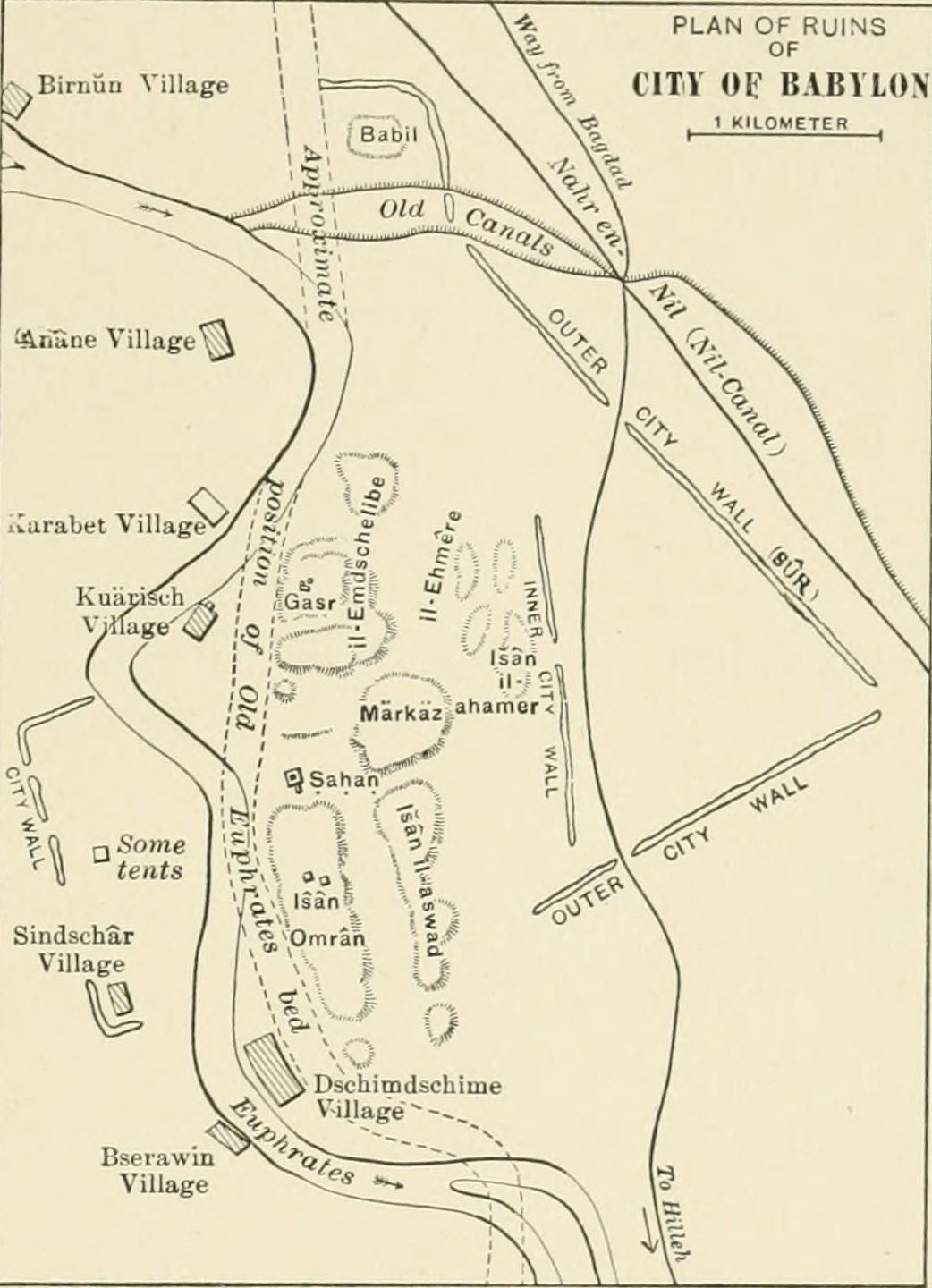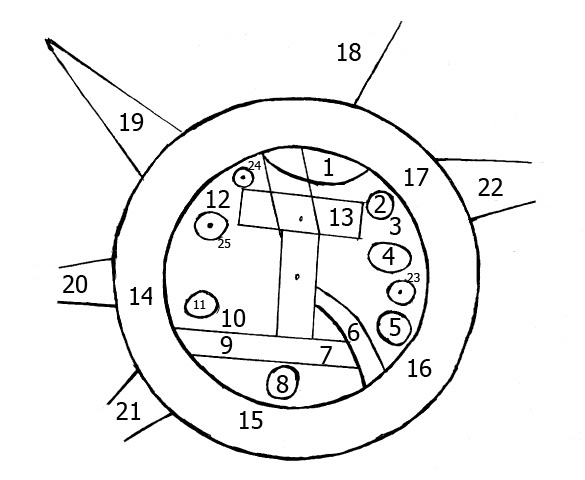Hanging Gardens of Babylon Facts
The name Babylon comes from the Sumerian language, meaning door of God, Babylon in Arabic, the ruins of this city are found in the province of Babylon in Iraq. It is located south of the Iraqi capital, Baghdad. It was the largest city at that time. It was the first city with a population of over 200,000.
Hanging Gardens of Babylon Real Images

By Unknown author - <a rel="nofollow" class="external free" href="http://www.plinia.net/wonders/gardens/hgpix1.html">http://www.plinia.net/wonders/gardens/hgpix1.html</a>, Public Domain, Link
The architect of civilization and the first king was the famous Amorite leader Sumuyabam.
King Hammurabi of the Babylonian civilization is a notable name. He was the 6th king of Babylon. He ascended the throne in 1792 BC.
Babylon Map
Map showing the Babylonian territory upon Hammurabi's ascension in 1792 BC and upon his death in 1750 BC

By <a href="//commons.wikimedia.org/wiki/User:MapMaster" title="User:MapMaster">MapMaster</a> - <span class="int-own-work" lang="en">Own work</span>, CC BY-SA 4.0, Link
Plan of ruins in 1905 with locations and names of villages

By <a rel="nofollow" class="external text" href="https://www.flickr.com/people/126377022@N07">Internet Archive Book Images</a> - <a rel="nofollow" class="external text" href="https://www.flickr.com/photos/internetarchivebookimages/14759211776/">Image from page 148 of "A history of all nations from the earliest times; being a universal historical library" (1905)</a>, No restrictions, Link
Babylon's greatest contribution was in the field of law, the law of the Babylonian king Hammurabi as a consolidation of the law was strict punishment, the convict was sentenced to death for a minor crime, if someone testified falsely on behalf of the convicted the punishment is same.
Description of the mapped areas
The map is circular with two outer defined circles. Cuneiform script labels all locations inside the circular map, as well as a few regions outside. The two outer circles represent water in between and is labelled as idmaratum "bitter river", the salt sea. Babylon north of center of the map; parallel lines at the bottom seem to represent the southern marshes, and a curved line coming from the north, northeast appear to represent the Zagros Mountains.
There are seven small interior circles at the perimeter areas within the circle, and they appear to represent seven cities. Eight triangular sections on the external circle (water perimeter) represent named "regions" (nagu). The description of five of them has survived.

By <a href="//commons.wikimedia.org/wiki/User:EvgenyGenkin" title="User:EvgenyGenkin">EvgenyGenkin</a> - <span class="int-own-work" lang="en">Own work</span>, Public Domain, Link
Objects on the Babylonian map of the world
1. "Mountain" (Akkadian: šá-du-ú)
2. "City" (Akkadian: uru)
3. Urartu (Akkadian: ú-ra-áš-tu)
4. Assyria (Akkadian: kuraš+šurki)
5. Der (Akkadian: dēr)
6. ?
7. Swamp (Akkadian: ap-pa-ru)
8. Susa (capital of Elam) (Akkadian: šuša)
9. Canal/"outflow" (Akkadian: bit-qu)
10. Bit Yakin (Akkadian: bῑt-ia-᾿-ki-nu) 11. "City" (Akkadian: uru)
12. Habban (Akkadian: ha-ab-ban)
13. Babylon (Akkadian: tin.tirki), divided by Euphrates
14 – 17. Ocean (salt water, Akkadian: idmar-ra-tum)
18 – 22. outer "regions" (nagu)
23 – 25. No description.
Carlo Zaccagnini has argued that the design of the Babylonian map of the world may have lived on in the T and O maps of the European Middle Ages.
Who Made the Hanging Gardens of Babylon?
The garden was built in 600 BC by Emperor Nebuchadnezzar and his wife. Which is one of the seven wonders of the world. Emperor Nebuchadnezzar was very merry. Nebuchadnezzar's wife was the daughter of the Median emperor. The Median emperor assisted Nebuchadnezzar in conquering the kingdom of Nineveh. It was then that he first saw the princess, attracted by the beauty of the Median princess, Nebuchadnezzar married her. After marriage, she became the empress of Babylon.
The empress did not like the city of Babylon, she had enough reasons, one of which is that Babylon is a flat land and Median was a country of green hills and mountains. The queen loved the hills and the plants. The emperor, realizing the distress of the empress, made a beautiful flower garden on top of the palace. At first a huge foundation of 800 square feet was built. The foundation was laid on the spacious roof of the emperor's special shrine. Its height from the ground is about 80 feet.
Five to six thousand types of trees are brought from different parts of the world and planted in the garden. Water is drawn from the river on the high steps of the garden with the help of thick spiral pipes.
Read More:
Babylon: A History of the City | What happened to Babylon?
What happened to the Hanging Gardens of Babylon?
Who destroyed the Hanging Gardens of Babylon?
The Persian emperor Cyrus captured Jerusalem in 514 BC and destroyed the city. They burnt down their shrines and palaces. From his time the Babylonian Empire began to fade. Nabonidus later became emperor. But the prosperity of Babylon is lost. Babylon is now a heap of ruins. The city of Babylon was reduced to dust by the onslaught of the Persian emperor.
Discussing the various aspects of the Babylonian civilization, it is clear that many of their contributions to the present civilization existed around the ancient city of Babylon.
Many civilizations have perished in the dust of the earth due to the riots and wars that have taken place from time to time.
How was today's content about the origin and destruction of Babylonian civilization, of course please let us know in the comment box, please share. Thanks
